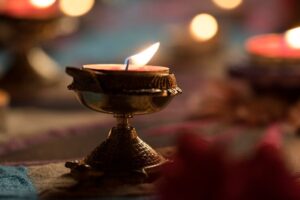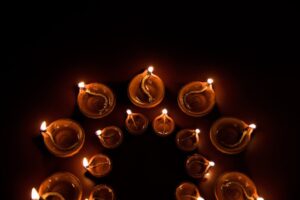
Lighting a lamp before a deity is a sacred ritual in Hinduism, embodying the transition from darkness to light and ignorance to knowledge. This practice is a daily occurrence in Hindu households and temples, symbolizing the presence of divine energy. Each type of lamp holds unique significance, serving different purposes in spiritual practices and rituals.
One Wick Lamp
The one wick lamp is a common fixture in Hindu worship, used primarily to honor Ishtadeva, the chosen deity of the worshiper. This lamp, typically fueled by pure cow ghee or sesame oil, is accompanied by a flower wick. The single flame represents focused devotion and is often used in regular household prayers.

Two Wick Lamp
A two wick lamp, with its dual flames, is specifically used in the worship of Bhagwati Jagadamba Durga Devi and Mata Saraswati. This type of lamp symbolizes the dual aspects of divine energy and is believed to aid in the pursuit of education and knowledge.
Three Wick Ghee Lamp
The three wick ghee lamp is an essential part of daily rituals for invoking the blessings of Lord Ganesha. The triple flames signify the removal of obstacles and the ushering in of prosperity and success.
Four-faced Mustard Oil Lamp
Lighting a four-faced mustard oil lamp is a practice aimed at pleasing Bhairav Devta. This ritual is believed to alleviate life’s troubles and protect the worshiper from harm.
Five-faced Lamp
A five-faced lamp is lit to seek the blessings of Lord Kartikeya, especially in matters involving legal disputes. The quintuple flames symbolize victory and righteousness.
Seven-faced Lamp
To ensure the constant blessings of Goddess Lakshmi, a seven-faced lamp is lit, particularly during the festival of Diwali. This ritual is meant to bring wealth and prosperity into the home.

Eight or Twelve-faced Lamp
Lighting an eight or twelve-faced lamp, made of ghee or mustard oil, is a practice dedicated to Lord Shiva. These multi-flamed lamps represent the various aspects of the deity and are used to seek his blessings.
Ten-faced Lamp
A ten-faced lamp is used in the worship of the Dashavatara, the ten incarnations of Lord Vishnu. This practice highlights the devotion to the diverse forms of the deity.
Sixteen Wick Lamp
The sixteen wick lamp is lit to honor Lord Vishnu, with each flame representing a different aspect of his divine form. This lamp is used daily to seek his blessings and protection.
Other Types of Lamps
Flour Lamp
A flour lamp, crafted from dough, is considered highly auspicious for any form of spiritual practice (sadhna) or achieving spiritual powers (siddhi).
Ghee Lamp
Lighting a lamp of pure ghee daily in the home temple is believed to resolve financial difficulties and please the deities.
Mustard Oil Lamp
Used at Bhairavji’s place, this lamp is believed to ward off enemies and please the Sun God.
Sesame Oil Lamp
This lamp is lit to resolve issues related to Saturn (Shani), bringing relief from its adverse effects.
Mahua Oil Lamp
Lighting a lamp of Mahua oil is a practice for wishing a long life for one’s husband.
Linseed Oil Lamp
To calm the effects of the Rahu and Ketu planets, a linseed oil lamp is used.
Triangular Jasmine Oil Lamp
This unique lamp, with three corners, is used to worship Sankatharan Hanumanji, ensuring his blessings.
Deep and Round Lamp
A deep and round lamp is lit to achieve personal wishes and gain knowledge.
Conclusion
Lighting lamps is more than just a ritual in Hinduism; it is a profound spiritual practice that connects worshipers with divine energy. Each type of lamp, with its specific significance and use, underscores the rich tapestry of Hindu worship and its deeply rooted traditions. By understanding and following these practices, devotees can enhance their spiritual journey and bring divine blessings into







